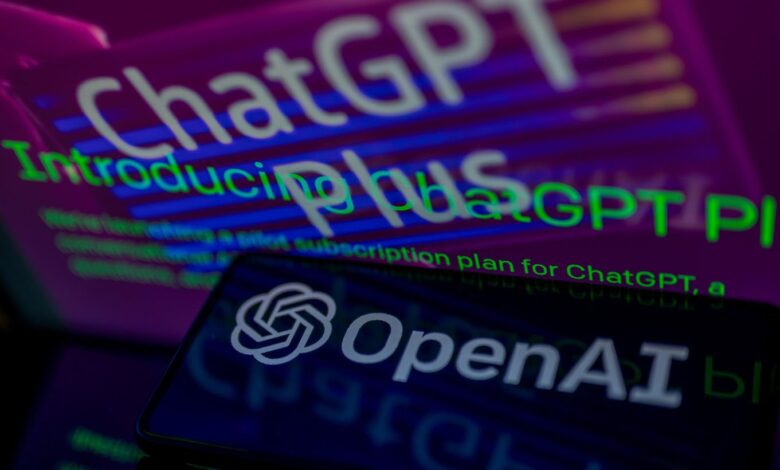With Generative AI Stocks Up 20%, Apple Searches For An AI Killer App

OpenAI displayed on a smartphone with ChatGPT 4 seen in the background, in this photo illustration, … [+]
Investing in a bundle of generative AI stocks has beaten the market for the last 18 months.
Indeed in 2023, my Generative AI Stock Index rose 85% — nearly doubling the Nasdaq’s 43% increase, according to my new book, Brain Rush: How to Invest and Compete in the Real World of Generative AI.
That outpeformance has narrowed in 2024. This year, GAISI’s advantage has shrunk to 5% after rising 20% — compared to the Nasdaq 15% increase, as of June 14.
This suggests trouble ahead for generative AI stocks. Unless people start to pay for the AI chatbots, a bet on the stock of companies building them could quickly lose money.
And since “even Apple can’t explain why we need generative AI in our lives,”according to the Financial Times, AI fever could cool off.
So what will make people feel compelled to pay for AI chatbots? In short, a killer app — such as the electronic spreadsheet was for PCs — that saves so much time and money or delivers so much happiness that people cannot resist paying for it.
The emergence of such a killer app for generative AI could be brewing among hundreds of experiments companies are making. However, fear of reputation-damaging hallucinations and a lack of product vision and execution skills are impeding the delivery of such a generative AI killer app, notes Brain Rush.
Why The Generative AI Stock Index Could Stop Beating The Market
The bundle of generative AI stocks includes shares of companies all along the network of industries designing, building, and operating AI chatbots.
As I described in Brain Rush, the generative AI value chain includes:
- AI management consultants.
- AI software providers including large language models and other AI applications;
- Providers of AI cloud services — bolstered by the likes of data centers, networking technology providers, and databases; and
- AI hardware providers — including AI chip designers and manufacturers as well as AI server makers and suppliers of heat removal technology.
In 2023, stock prices for all the GAISI components were up — with AI hardware and software taking the lead — as detailed below.
- Generative AI consulting: +30%.
- Generative AI software: +91%.
- Generative AI cloud services: +70%.
- Generative AI hardware: +135%.
So far in 2024, GAISI is up a more modest 20%. Only AI hardware stocks continued to rise considerably. Average stock prices in the remaining index components slowed down or fell. Here’s how much:
- Generative AI consulting: -18%.
- Generative AI software: +17%.
- Generative AI cloud services: -10%.
- Generative AI hardware: +92%.
What explains the difference between the winners and the losers? In a nutshell, the winners beat often high expectations and raised their forecasts for the rest of the year. The losers disappointed investors — offering tepid growth forecasts and/or falling short of investor estimates.
Here are a four examples:
- MongoDB (stock price down 44% in 2024 as of June 14). This database software provider blamed disappointing growth guidance for the current quarter and year on “macroeconomic conditions,” according to CNBC.
- Snowflake (-36%). This AI cloud service provider’s stock fell when a new CEO was appointed in February who issued a mixed first-quarter report featuring lower margins and modest guidance, I noted in a June Forbes post.
- Nvidia (+166%). This AI chip designer managed to beat high growth expectations and raise its growth guidance. I explained how and why the stock could keep going up in a June Forbes article.
- Vertiv (+91%). This provider of liquid cooling technology faces lower investor expectations and less technical and competitive risk than Nvidia and forecasts solid double-digit growth, I noted in a May Forbes post.
What Is Generative AI’s Killer App?
While no single reason explains the recent down slide in the performance of generative AI stocks, ultimately the success or failure of the generative AI boom will depend on the emergence of an obvious killer app.
Now companies are investing in the technology because they are afraid of falling behind their peers.
However, unless a killer app for generative AI emerges soon, companies may decide to back off. If that happens, demand for products and services provided by all the companies in the generative AI ecosystem could decline.
Apple’s inability to define a compelling reason why people need generative AI could mean trouble. That’s because “Whenever a new technology comes along, the world has traditionally looked to Apple to know what to do with it,” Financial Times noted.
Unlike, say, the App Store did for the iPhone, the AI that Apple demonstrated at this week’s World Wide Developers Conference did not create a reason for people to rush out and buy new Apple devices.
With rivals already showing AI as a more natural way of interacting with computers, as exciting features added to existing apps, or as a better way to search; Apple Intelligence may “not do any of them particularly well,” concluded the Financial Times.
Microsoft has not reported revenue for its AI Copilot. This suggests that the number of people paying the extra $30 per month per user for the service remains too small. Indeed, as I wrote in Brain Rush, many companies are searching for why Copilot’s value to them is worth paying 50% more for their Microsoft Office 365 services.
Based on my interviews with dozens of business leaders, generative AI in companies is caught in a bipolar battle.
Peer pressure forces CEOs to tell Wall Street how generative AI will transform their business. That pressure is reflected in a record level of mentions of the term “AI” in investor conference calls.
How so? A review of all the S&P 500 conference call transcripts from March 15 through May 23 counted 199 uses of the term “AI” — “well above the 5-year average of 80 and the 10-year average of 50,” according to FactSet.
At the same time, CEOs fear generative AI hallucinations could threaten their company’s reputation. This fear is based in reality. For instance, Google’s AI advised people to add glue to pizza, Forbes careers contributor Jack Kelly noted.
And Air Canada’s AI chatbot made up a refund policy for a customer — and a Canadian tribunal forced the airline to issue a real refund based on its AI-invented policy, Wired reported.
This inconsistent battle has significant implications for business. Of 200 to 300 generative AI experiments the typical large company is undertaking, a mere 10 to 15 have been rolled out internally, and perhaps one or two have been released to customers.
That’s according to Liran Hason, CEO of Aporia, a Manhattan-based startup offering guardrails to protect companies from AI hallucinations according to a June 3 interview.
The cost of building and operating AI chatbots is high. Unless a killer app emerges for generative AI that requires people to upgrade their digital devices, the stunning rise in generative AI hardware stocks will slow as suppliers fall short of investors’ high growth expectations.



